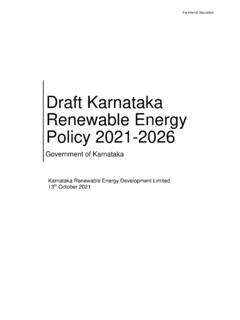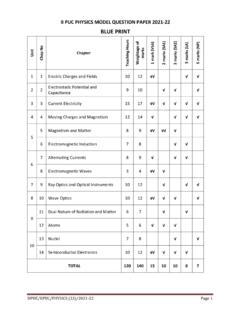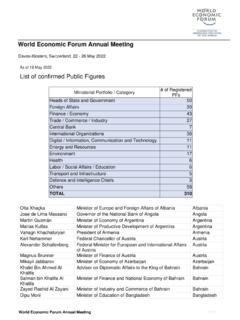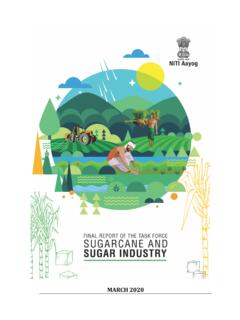Transcription of Climate Change in South Asia: Strong Responses for …
1 The views expressed in this publication are those of the authors and do not necessarily reflect the views and policies of the Asian Development Bank (ADB) or its Board of Governors or the governments they represent. Accounts presented here are anecdotal, and do not represent complete impact of a project or does not guarantee the accuracy of the data included in this publication and accepts no responsibility for any consequence of their making any designation of or reference to a particular territory or geographic area, or by using the term country in this publication.
2 ADB does not intend to make any judgments as to the legal or other status of any territory or encourages printing or copying information exclusively for personal and noncommercial use with proper acknowledgment of ADB. Users are restricted from reselling, redistributing, or creating derivative works for commercial purposes without the express, written consent of , Impacts, and Responses4 Projected Impacts of < < strong >Strongstrong > >Climatestrong >Strongstrong > > Change9 Other Natural Disasters10 ADB in Action14 < < strong >Strongstrong > >Climatestrong >Strongstrong > > < < strong >Strongstrong > >Changestrong >Strongstrong > > Solutions at the Regional and Country LevelsRegional ResponsesCountry-Specific ResponsesGoing ForwardFor more information about the < < strong >Strongstrong > >Southstrong >Strongstrong > > < strong >asiastrong > < < strong >Strongstrong > >Climatestrong >Strongstrong > > < < strong >Strongstrong > >Changestrong >Strongstrong > > Program, contact.
3 Hans CarlssonClimate < < strong >Strongstrong > >Changestrong >Strongstrong > > Focal Point < < strong >Strongstrong > >Southstrong >Strongstrong > > < strong >asiastrong > DobiasSenior Adviser, < < strong >Strongstrong > >Climatestrong >Strongstrong > > < < strong >Strongstrong > >Changestrong >Strongstrong > > Program Coordination Unit, Regional and Sustainable Development Photo credits: 12 13, ADB Photo Library; 23, Kage Gozun; 16 17 (bottom) James Hutchison; 20 21 Ariel Javellana; 6 7, (top) Kiran Panday; 6 7 (bottom), 10 11, 14 15, 18 19, 24 25, Rakesh Sahai; 16 17, (top) Eric Sales; Front cover, 22, Mookiah Thiruchelvam; 2, 3, 5, 8, 9, Adrian Young; 4, Frances Young < < strong >Strongstrong > >Climatestrong >Strongstrong > > < < strong >Strongstrong > >Changestrong >Strongstrong > > is an issue that many have called the greatest development challenge of our generation.
4 And through our Strategy 2020, the Asian Development Bank (ADB) has committed to reduce impacts of < < strong >Strongstrong > >Climatestrong >Strongstrong > > < < strong >Strongstrong > >Changestrong >Strongstrong > > as part of our efforts to achieve environmentally sustainable economic growth. What happens in < < strong >Strongstrong > >Southstrong >Strongstrong > > < strong >asiastrong > will clearly have a profound impact since the countries of this region are growing rapidly and are extremely vulnerable to < < strong >Strongstrong > >Climatestrong >Strongstrong > > impacts. If we cannot successfully meet the < < strong >Strongstrong > >Climatestrong >Strongstrong > > challenges here, then there is little chance that the world will be successful either. Thankfully, < strong >asiastrong > has not been idle and < < strong >Strongstrong > >Southstrong >Strongstrong > > < strong >asiastrong > in particular is emerging as a global leader in aggressively responding to < < strong >Strongstrong > >Climatestrong >Strongstrong > > < < strong >Strongstrong > >Changestrong >Strongstrong > > .
5 Through the < < strong >Strongstrong > >Southstrong >Strongstrong > > Asian Association for Regional Cooperation, countries have committed to a shared set of priorities in addressing < < strong >Strongstrong > >Climatestrong >Strongstrong > > < < strong >Strongstrong > >Changestrong >Strongstrong > > including ambitious targets for clean < strong >energystrong > and low-carbon technology development, as well as commitments to improve resilience of communities and economies. Efforts to secure adequate water and food supplies are of critical countries in < < strong >Strongstrong > >Southstrong >Strongstrong > > < strong >asiastrong > are also working to address < < strong >Strongstrong > >Climatestrong >Strongstrong > > < < strong >Strongstrong > >Changestrong >Strongstrong > > at the national level. The following pages discuss the different approaches to addressing the diverse and urgent adaptation and mitigation needs in every country in < < strong >Strongstrong > >Southstrong >Strongstrong > > < strong >asiastrong > , many with support from ADB.
6 This publication is intended to not only heighten general awareness about < < strong >Strongstrong > >Climatestrong >Strongstrong > > < < strong >Strongstrong > >Changestrong >Strongstrong > > in < < strong >Strongstrong > >Southstrong >Strongstrong > > < strong >asiastrong > and emerging policies and strategies but also to invite cooperation among partners to scale up successful < < strong >Strongstrong > >Responsesstrong >Strongstrong > > to < < strong >Strongstrong > >Climatestrong >Strongstrong > > < < strong >Strongstrong > >Changestrong >Strongstrong > > , and mobilize additional financial and technical resources that countries in < < strong >Strongstrong > >Southstrong >Strongstrong > > < strong >asiastrong > urgently will continue to increase efforts and deepen partnerships to help < < strong >Strongstrong > >Southstrong >Strongstrong > > Asian nations, and partners around the world, to move toward a more < < strong >Strongstrong > >Climatestrong >Strongstrong > > -secure future. Sultan Hafeez Rahman Director General < < strong >Strongstrong > >Southstrong >Strongstrong > > < strong >asiastrong > Department 1 The < < strong >Strongstrong > >Southstrong >Strongstrong > > < strong >asiastrong > region stretches from the towering Himalayan peaks of Bhutan and Nepal, to the fertile delta of Bangladesh and peninsula of India, and the jewel-like islands of Sri Lanka and the Maldives in the Indian Ocean.
7 Covering climatic zones as diverse as its physical landscape, the region is experiencing an array of < < strong >Strongstrong > >Climatestrong >Strongstrong > > < < strong >Strongstrong > >Changestrong >Strongstrong > > impacts, including glacial melt, forest fires, rising sea levels, mountain and coastal soil erosion, and saline water intrusion. Abnormal monsoon patterns and more frequent and intense storms have aggravated natural disasters and < < strong >Strongstrong > >Climatestrong >Strongstrong > > < < strong >Strongstrong > >Changestrong >Strongstrong > > impacts in recent years. Bearing the brunt of these are the more than 600 million absolute poor more than half of the world s total poor living in the region, who depend on < < strong >Strongstrong > >Climatestrong >Strongstrong > > -sensitive sectors including agriculture, forestry, and traditional fishing for much of their day-to-day needs.
8 With changes in the global < < strong >Strongstrong > >Climatestrong >Strongstrong > > system likely to span into the next century, geography, high population density, and immense poverty will continue to make < < strong >Strongstrong > >Southstrong >Strongstrong > > < strong >asiastrong > especially vulnerable. Human health, biodiversity, agricultural production, food security, water, < strong >energystrong > , and coastal settlements will be imperilled, as natural disasters worsen and migration grows intensifying stresses on major cities. 2 ! The snowy mountains of Himachal Pradesh, IndiaIn partnership with developing member countries, ADB continues to respond to these enormous < < strong >Strongstrong > >Climatestrong >Strongstrong > > < < strong >Strongstrong > >Changestrong >Strongstrong > > challenges.
9 ADB assists in reducing greenhouse gas emissions, focusing on the < strong >energystrong > , urban, and transport sectors. ADB will help reduce < < strong >Strongstrong > >Southstrong >Strongstrong > > < strong >asiastrong > s vulnerability by undertaking < < strong >Strongstrong > >Climatestrong >Strongstrong > > and disaster risk screening of projects, assisting in the integration of < < strong >Strongstrong > >Climatestrong >Strongstrong > > < < strong >Strongstrong > >Changestrong >Strongstrong > > in national development, and strengthening capacities in adaptation planning and implementation. Consistent with ADB s Strategy 2020 to incorporate environmental sustainability in the fight against poverty, < < strong >Strongstrong > >Climatestrong >Strongstrong > > < < strong >Strongstrong > >Changestrong >Strongstrong > > efforts are guided by five strategic priorities: expanding the use of clean and renewable < strong >energystrong > ; encouraging sustainable transport and urban development; promoting < < strong >Strongstrong > >Climatestrong >Strongstrong > > -resilient development, especially in the agriculture- and water-dependent sectors; strengthening policies, governance, and capacities; and managing land use and forests for carbon !
10 ! 4 Breakwater along the coast of IndiaSouth < strong >asiastrong > is vulnerable to several < < strong >Strongstrong > >Climatestrong >Strongstrong > > < < strong >Strongstrong > >Changestrong >Strongstrong > > issues and impacts tied closely to the region s geography, economy, and population patterns " # ! ! Glacial MeltThe Water Towers are CrumblingThe Himalayas are a lifeline to some billion people living directly in the floodplains of its many rivers. About 10% of the volume of Himalayan rivers comes from melting water from glaciers, which are essential to sustain river flows during dry But with rising temperatures, the ice mass of the Himalayas is retreating more rapidly than the global average.

















